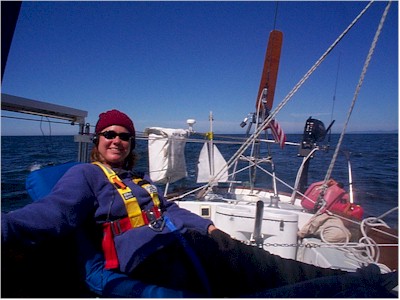
A great first day at sea
 |
|
A great first day at sea |
Tuesday, August 13th (Happy Birthday, Michael!) we motored out of Neah Bay under a clear blue sky. The winds were nonexistent for our first few hours, so we motored with the sails up, waiting for the promised NW winds to fill in. By 1300 the winds finally picked up, and we had a really nice smooth sail under main and genoa for the rest of the day. We hooked up the Monitor and was thrilled to see it steer the boat in a nearly perfect course. At 0330 Zulu, we checked into the Pacific Seafarer's Net with our first report. All evening the winds slowly began to build, so we put two reefs in the main before nightfall and continued to cruise nicely downwind with the genoa.
We had both put on Transderm-Scop patches the morning we left so were feeling no effects of mal de mer. I (Sara) had the first watch (9P-12A) and really enjoyed the clear brilliantly starry sky and half moon shining across the water. The wind continued to build, but we were still moving comfortably at 6-7 knots when Michael came on watch at 12am.
By the end of Michael's watch, the wind was blowing over 30 knots and the seas had built to where they had started to break behind the boat every few minutes. The boat was incredibly overpowered with the huge genoa. Just as I had got on my foulies and harness, the boat skidded down a wave and jibed. The boom preventer kept the main under control, but the genoa was chafing madly on the spreaders and shrouds. Michael went forward to take down the genoa which was very difficult back-winded in the 35 knot winds, but finally he got it strapped down on the foredeck. With only the double-reefed main up, the boat would only round up into the wind, and we found ourselves hove-to with the bow into with wind and waves.
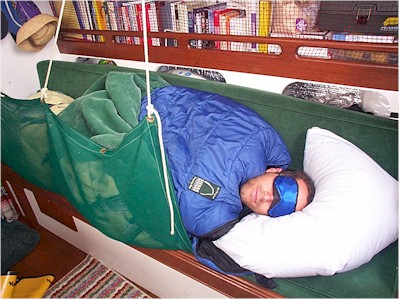 |
|
Michael getting some zzzzz's |
It was actually a very comfortable position as the breaking waves would just roll under the boat, so we stayed like that, with the main back-winded and the tiller tied off for the rest of my watch, until the sun rose around 0600. Near the end of my watch, the wind appeared to die down a bit and I was able to get the boat to steer downwind again, hooked the Monitor up once more and got us steering south. We listened to the VHF weather forecast and heard that winds were strongest where we were, 20-60 miles offshore (we were 40 miles off the coast at this point), and lighter near the coast. We turned Pelican to the SE to get out of the still snarling waves.
By 1300, the winds had died considerably and we hanked the jib on the forestay. We talked on the VHF to another boat sailing nearby and they reported they'd had no strong winds where they were closer to the coast all night. By 2000 the wind was down to about 5 knots and the sails were flogging miserably in the swells so we reluctantly started up the engine. We motored through the night and by morning had decided to pull into Newport, Oregon to fill up on diesel unless the winds picked up. We only carry 32 gallons of diesel so only have a 48 hour motoring range. Ordinarily this would be fine, but as we found out on this part of the coast the more diesel the better....
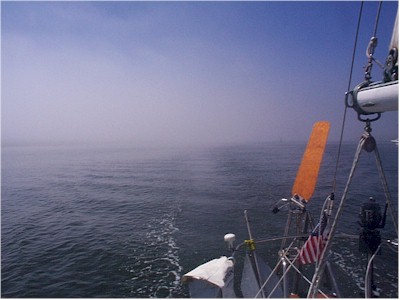 |
|
Newport, Oregon fog |
Nearing Newport later that afternoon, we talked to the Coast Guard on VHF who gave us a bar report for Newport -- calm, but foggy. All the way down the coast, we found the Coast Guard to be incredibly helpful to both ourselves and many other boats. They really do an amazing job at assisting mariners of all sizes and we have a new respect for them.
At Newport, we poked our way in between the jetties with our radar. It was sunny but the fog was so thick we couldn't see the jetty's until we were inside them. We could hear the breakers clearly though, so it was a bit nerve-wracking. Once in Yaquina Bay, the fog cleared and we tied up at the hotel marina. First thing we took long hot showers, then set out for dinner. It seemed like we'd left Neah Bay ages ago and thoroughly enjoyed walking on land again. In a local marine store, we picked up the chart of the Crescent City, CA harbor as some friends had stopped in there a week before after encountering strong winds off Cape Blanco, and hoped it would be insurance that we'd have a good easy passage.
The next morning with a full diesel tank and jerry jugs, we motored out of Newport with a good weather forecast for the next few days. We sailed for a few hours with 8 knots NW wind, then around 1600 the sails started flogging again as the wind dropped. We started the engine once more and continued down the Oregon coast, about 15 miles offshore, in search of some winds that would at least keep the sails full. By 1000 the next morning, we happily set our jib and single reefed main as we found some wind at last. Over the next few hours, the winds continued to build and we put another reef in our main. An hour later, we took down the jib as we were surfing down waves at over 8 knots. But without the headsail, the boat wanted to round up into the wind, so we took down the main completely and put the jib back up. We sailed like this for a few hours, going at 6-7 knots with only our 90% jib as the wind and waves continued to build.
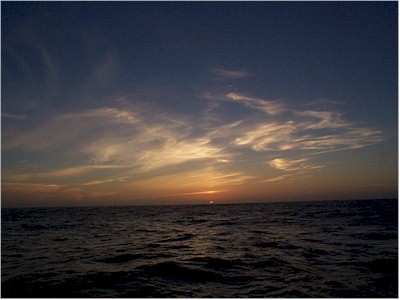 |
|
Offshore sunsets are beautiful |
Our port tack downwind was bringing us closer to shore, so we jibed and started heading more SW, away from land. By evening, the winds were blowing at least 40 knots, with 18 foot seas and the boat was going incredibly fast. We decided it was time to put up our teeny storm jib. With this handkerchief-size sail up, Pelican was still flying along at 6 knots. All around us the seas were snarling angrily, with large breaking seas threatening to fill our cockpit (and a few that did). Spray was filling the air and foam was beginning to cover the surface of the water. We continued flying downwind, and guessed that it was blowing 50 knots at times. Cape Blanco was in full form, as most of the cruisers would encounter in this area the entire month of August.
At 8 pm, we had our scheduled SSB contact with our friends who had arrived in San Francisco the week before. They gave us some encouragement (as they had encountered the same winds we were having), but told us the weather forecast was for the winds to continue for three days or so. We had initially decided to keep sailing through, as the sailing was fairly comfortable with the storm jib and our amazing Monitor continued to keep us on course. Our nerves were starting to get fairly shaken and we were getting quite tired as sleep was impossible. We were due east of Crescent City, about 30 miles offshore. Going in would mean having the huge seas on our beam, but it would also mean a calm harbor and sleep in less than six hours. We decided to go in.
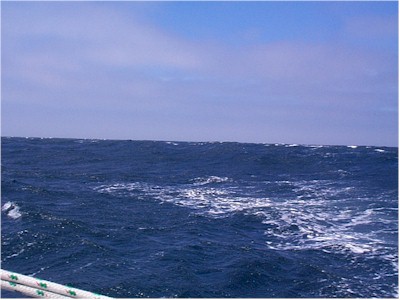 |
|
Big bad blue waves |
Heading east, we were on a nearly beam reach, and the seas crashed continuously over the boat. Once we got the Monitor set on our new course, we put the hatch boards in and went below. Watching the track on our GPS, we were amazed as Pelican would get knocked over by a wave, and we'd see white water crashing against the ports on both sides. Then she'd pop right back up and continue on course like nothing happened, the Monitor hardly missing a beat. Pelican is so wonderfully stable at sea, despite her relatively small size and we felt safe being tucked inside. Over and over, we'd hear a wave roar and crash over the side, but Pelican would just bob right back up and continue sailing her course. Despite the seas, we made good time nearing the coast, still making about 6 knots an hour.
We spoke to the Crescent City Coast Guard, requesting an area forecast and were happy to hear it was only blowing 10 knots in the harbor, with good visibility. We also spoke on the VHF with another boat in the area that had just gotten below St. George Reef and he reported much calmer winds and seas below the large reef than he'd experienced farther north.
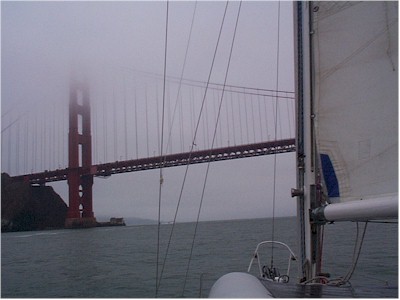 |
|
Golden Gate bridge!!! |
As promised, when we got below St. George light, the winds quieted and the seas were much less menacing. We cheered when we saw land on our radar screen! It was about 0400 the next morning when we sighted the lights of Crescent City and were able to turn the engine on to creep into the harbor in the dark. Following a couple of GPS waypoints we'd checked and rechecked and rechecked again, we made our way through the rocks and buoys and into the inner harbor, Once in, we dropped our anchor and fell into bed and much needed sleep. We had never felt such happiness and relief than we did that morning when we were safely anchored and rid of those horrible winds and seas.
We spent the next four days at the Crescent City docks waiting for the winds to die down offshore. It was a great break; we took a number of showers, did laundry, saw a movie, and ate out probably too many times. We enjoyed every minute of land life.
Here, we spent some time inspecting our battered rig, which happily checked out great. We had to rethread our main jib halyard through it's block as the halyard had gone up the mast during the blow. Our tillerpilot used mainly when motoring was suddenly not working at all, so we ordered a new one and sent the old one back for warranty repairs. (Oh well, it will be nice to have a spare.) Other than these few things, and a few new tears in our old sails, the boat and her equipment had fared marvelously well through the storm.
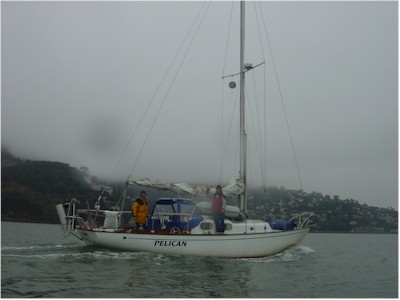 |
|
Two tired excited sailors |
When the coastal forecast to Cape Mendocino and to S.F. was for 5-15 knots variable for a few days in a row, we motored out of Crescent City, with a couple more jerry cans of diesel added. Nerves still shaken, we did not care if we had to motor the next 250 miles to San Francisco. And motor we did, as we did not see winds over 8 knots during the next 48 hours, even off Cape Mendocino.
Finally, two weeks to the day from when we left Camano Island, on Saturday August 24th, we put our main up to motorsail underneath the Golden Gate bridge at 0930 in the morning. Of course, it was partly hidden in fog, but we could see most of it as we passed underneath. Nearing Sausalito, our friends Eric and Angela on Rouser greeted us in their dinghy. What a great feeling as we dropped our hook near their boat in Richardson Bay off Sausalito -- we had made it to San Francisco!